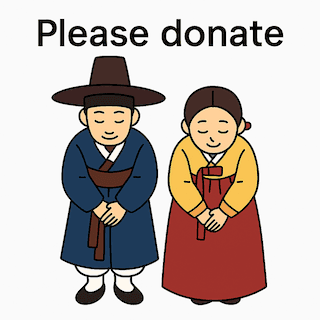The potential is still hidden for Europe.
Hugo J. Smal has shared his fascinating big Korean adventure, his experiences in Korea, particularly focusing on the koi culture and his adventures in the country. He has been involved in setting up koi facilities and has written about his experiences, including the challenges and cultural insights he encountered. If you’re interested in learning more about his adventures, you might want to check out his writings on “Koreans and I“. South Korea has several fanatical and ambitious koi lovers. Hugo Smal has been well established in this fascinating country for quite some years now. He has assisted several founder members of the koi hobby in setting up the right facilities. A report of a fascinating stay in a fascinating country. This article was published in a dutch garden magazine.
He tells his adventures in Korea.

During the Holland Koishow of 2003, the organisation asked me to arrange a fish tank and provide it with good water and oxygen. A few Koreans brought koi on a plane to the Netherlands to participate in a competition and sell some koi. With the cooperation of several traders, they succeeded in both endeavors. The opportunistic Koreans filled the tank with their koi, placed some in the competition and had a good show. Not only did they sell quite a few fish, but they also won some of the lesser prizes in the show. During those days, koi lover and C.E.O of the Goyang Koi farm Kim Young Soo asked me if I wanted to come to Korea to help him with setting up a koi industry in his country. Who am I to say no to this big Korean adventure.
Struggling farmers.
China exported more and more rice to South Korea This made the farmers struggle. It was Kim Young Soo’s vision that the cultivation of the Japanese ornamental carp will be a good alternative for rice cultivation. The ambitious grower’s request was a challenge for me. Less than a month later, I was in Incheon, the Seoul airport.
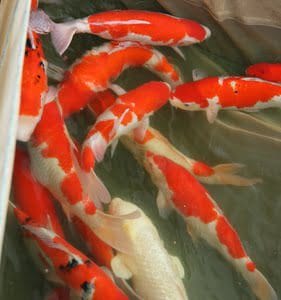
From the airport, I was driven directly to a koi show where I had to give a short speech. The organization wanted me to judge. I did not feel qualified for that. Of course, they asked me what I thought was the best fish. For me, it could only be that a strong Sanke should win. The other fish were not really of good quality. To my surprise, a Showa won the main prize. This fish was certainly of lesser quality – so much knowledge I have – and was also sick on the bottom of the vat. “According to our standards this fish would be removed from the competition”, I noticed against a journalist.
A fierce argument during my Korean adventure.
After my remark, a loud tumult broke out. Tumult? Let’s just call it a fierce argument. I was put in a Kia Van and dumped after a long journey in a hotel room. “There you are,” I thought. “What had happened? What task, if any, still awaits me?” This show was certainly not well organized and the judges lacked the necessary knowledge. It smelled of clientelism and perhaps even bribery. Moreover, it was clear that no benching was done and no distinction was made between healthy or sick fish. Worldwide the koi are tested on health before the competition by skilled hobbyists, often with support from a veterinarian specialized in fish diseases. Not in South Korea at that time. Mind you: this happened in 2003.
The next morning I was picked up by a somewhat timid Kim Young Soo and his companions. In the back of the van there were big fish boxes. Sometimes their sounded big splashes. Later this turned out to be the sanke that should have won. Kim Young Soo was the owner. He had taken to heart my words, which were too honest for the Korean culture. He decided that he would take the lead in the Korean koi industry.
Korea is a big adventure!
During the rest of that trip, I got to see the impressive nature of the land of the morning calm. I also gained a deeper insight into the culture. I realized that the Koreans would have to do a lot of koi studies. And I would have to dig deep into this very wondrous society. I was introduced to a large number of artists. Baik Yong-Jung taught me that the carp has been deep in the Korean soul for centuries. This traditional artist paints nature experiences with carp. These always have a deep meaning. Õhado for example paintings of carps and crabs frequently occurred during the Yi dynasty (1362 -1905). Yangnido or ŏbyŏnsŏngyongdo are scenes of carps jumping in the air.
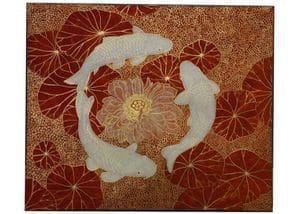
Garp myth.
The paintings draw inspiration from the following story: the Yellow River in China rises from the Dragon Waterfall. When heavy rains cause the water to rise in the river, old carp fight each other when they swim against the strong current. If one of the carps won and he reaches the tip of the waterfall. Their the fish passes the Dragon gate and turns into a dragon. Read much more about carps and Korea.
During the Confucian Yi Dynasty, this story symbolized the hope of getting the state exam and becoming a civil servant. This was the only way to get from poverty to wealth. Now it stands for the hope of obtaining diplomas and becoming something in life.
This is just one example of how carps play a role in society. A painting featuring carps is now a common wedding gift. Conversations with artists like Baik Yong-Jung and research in literature have shown that the carp, as a cultural symbol of China, traveled through Korea to Japan. In this way, South Korea culturally remains about 210 kilometers (the distance from Busan to Fukuoka) ahead of Japan.
Visionary idea and a real Korean adventure.
This, of course, does not apply to the carp as ornamental fish. In that respect, Japan has had a lead of more than 100 years. It seemed to me, therefore, an idiotic idea to think that the Korean koi farmers could ever compete with Japan on the quality of the go sanke class. I, therefore, suggested the idea of linking the koi to the Korean culture and thus also expanding the koi farm in Goyang Si, northwest of Seoul, into a cultural centre where, for example, ceramics and paintings would be exhibited.
All this was initially to introduce the Korean people to the koi hobby, with the ultimate goal of starting the export of both koi and koi-related art. I knew that Koreans view everything as a competition and strive to be the biggest, strongest, and best at everything. Understanding this mindset might be the greatest adventure in Korea. Kim Young Soo traded one piece of land for another, dedicating himself to studying and building. He invested significantly in Japanese parent koi pairs and began breeding and growing them.
Now I was already accustomed to advising in the Netherlands on koi ponds in difficulties. Sometimes with the purchase of fish. Kims urge to act turned out to be a very big challenge. I know not a lot about how a koi farm should be run. Luckily I could always rely in the Netherlands on experts such as René Krüter with questions about fish diseases and water quality and Mark Kleijkers when it came to the quality of the koi. In addition, I also have a good sense. I succeeded in supporting the task that the Koreans had taken on. Also, this proved to be a big Korean adventure.
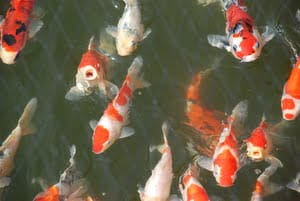
Rising quality, promises a big Korean adventure
I saw the quality of the fish on the Goyang koi farm rise year after year. Kim Young Soo joined forces with mister Hong who had a significant number of breeding ponds near Gwangju. In a large number of mud ponds, top quality Go sanke. Fish that I would not refuse access to my pond.
After a long build-up of trust, talking and negotiating, Kim and Hong finally decided to enter the Hong fish at the Holland Koi show in 2011.
I travelled to South Korea together with René Krüter to select the fish. We thought they want to compete with smaller sizes of fish. But the Koreans thought completely different. They immediately wanted to win with large koi.
As children, René and I stood by the ponds, watching as one Jumbo koi after another was netted and placed into vats. Just seeing those fish was a blessing. It was a true Korean adventure with a Japanese twist. And now, they were coming to the Netherlands. Where would I keep them? My pond had been empty for several years due to the collection of fish from Korea. A few goldfish provided the necessary relief for the bacteria. I had about a month to get the water in top condition so that the fish could acclimate for a few months before heading to Arcen.
I decided it would be possible. My pond and filter were good enough for those Jumbo’s of top quality to enjoy my hospitality for a while. I ordered two vats for Arcen because the six fish we had chosen was too big for one.
European legislation.
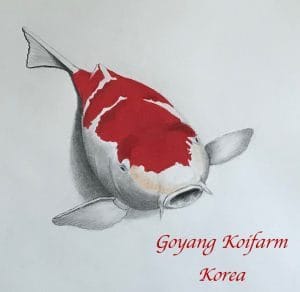
“Because between dreams and reality, there are laws and practical misgivings.” Koreans will not have heard of Willem Elschot, but this sentence from “The Marriage” is applicable. In the OFI (Ornamental Fish Industry) journal, October 2008, Alex Ploeg had already written: “Asia breeders and exporters of live fish, crustaceans and molluscs for ornamental purposes might think:
” I am a Japanese, Indonesian, Malaysian, Chinese or Singaporean citizen, so why should I worry about European legislation? “
In a survey, 74% of Asian exporters indicated that they are trading with Europe, so I think we can assume that Europe is one of the most important markets for their products. European import legislation not only affects importers in Europe but also exporters in Asia, their suppliers, growers and collectors.
If the exporters want to sell their products on the European market, they have to comply with European animal health standards. Suppliers must supply fish that meet these standards.
Never enough Korean adventures.
The exporting country must also meet these standards. ” Of course, I had pointed out Kim Young Soo to European legislation. I always based all my advice on the OFI Code of conduct. He, his employees and the co-operating Korean koi breeders did not ignore these recommendations. They had called upon the right officials in their districts and even those from the right ministries and asked for the application for an export license for fish to the European Union.
But yes, things sometimes go differently… Kim Young Soo and mister Hong were standing with the fish at Incheon Airport when the sword of Damocles fell. It cut off all possibilities at once. Customs said that the fish could fly to Europe, but that they would be stopped at the border. This would mean that they would enter into the shredder. It was all very disappointing. A bad Korean adventure.
Hidden Dragon, crouching tiger
In the years that followed the Korean adventures grow. I have often been to South Korea. Kim Young Soo and I joined discussions with top civil servants at the ministries. They get my advice and sometimes my opinion in a too European way. I know that the official wheels are running but they are running very slowly. South Korea is still a hidden dragon and crouching tiger in terms of koi.
The Chinese now buy all fish in Japan and want to play a part in the koi hobby soon. So the question is whether the official wheels in South Korea do not run too slowly and that it will therefore only stay with grunts. Fortunately, Kim Young Soo took my advice not only to gamble on koi. He invested around 5 million euros – based on my advice. Yes, I shudder. He built a koi and cultural centre. It has now opened its doors under the name Baedagol.
When you did get exited about this big Korean adventure follow us on facebook: Goyang Koi farm 비단잉어 Nishikigoi
